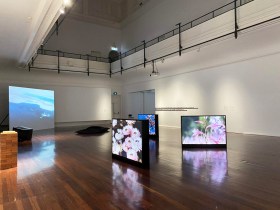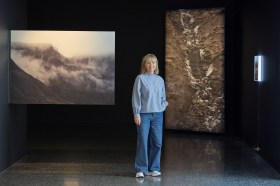In 2011, Indigenous artist Richard Bell chose the winner of the $20,000 Sulman Prize based on a combination of his own criteria (liking animals), looking out for his friends and, most controversially, a coin toss. While much of the commentary treated it as a disrespectful stunt, it missed that it was a reveal. Where the winning artist felt that they would rather have been selected based on their merit, Bell named how ‘like every prize, it’s a lottery’. Choices are never made on merit alone when there are aesthetic subjectivities and social capital at play.
This is particularly true when the selection rests on the decisions of the one individual who is structurally positioned as the gatekeeper of others’ success – a structure overwhelmingly reflecting the colonial-capitalism that excludes so many by design. Within this paradigm, a transparent lottery selection may actually be fairer. It may have more chance of going to the most deserving. It may go to someone who is persistently encouraged to compete, despite having to disproportionately contend with the dark aspects of meritocracy – where there is only one person rewarded and others must suffer loss, rejection and exclusion.
The idea that there is a valid method involved in who succeeds and who is deserving is a strong cultural mythology. Daniel Markovits writes in The Meritocracy Trap that ‘the meritocratic ideal … anchors the self-image of the age’. The notion that wealth and status should be earned through accomplishment parades itself as basic decency and pervades the background of everyday experience, comprehensively organising the structures that determine our work and lives. Many even view it as healthy and necessary for producing and safeguarding quality. All the while it makes alternative methods for awarding advancement seem absurd, unfair or even corrupt (for example, selecting based on need rather than merit).
However, where it was imagined that meritocracy may accurately reward talent and hard work, in reality it operates ‘through more and more intensive cultivation of nurtured talent, extending longer and longer’, Markovits writes. It becomes a system of sorting into a class structure that begins with the birth lottery – already a life condition that exists outside of individual choice, talent or drive, but defines so much of what we are able to do in our lifetime. Meritocracy persists because it is a way to uphold inequality, by having all people compete from birth in a system suited to just a few.
Meritocracy and the art industry
As artists weathered new COVID-infused precarities, writer Jinghua Qian expressed eir frustrations around continuing to compete for grant funding. Ey described the sense of confusion, humiliation and physical tension in competing for something that presents rhetorically as oscillating between an act of charity and a government investment, all the while operating as something more akin to the mutual obligation system for welfare recipients.
However, for em, it was worse than engaging with the punitive processes of JobSeeker, because at least JobSeeker does not have a lottery element on top: ‘As awful as Centrelink is, arts funding is somehow even worse. At least the dole is ongoing… Arts funding bodies, on the other hand, want you to craft a 10-page proposal to compete for a minuscule chance at a trickle of money’. Ultimately, ey wrote, ‘I don’t believe in meritocracy. I don’t believe in excellence. Survival is not a reward.’ Eir article makes clear that it takes a specific kind of person with certain supportive life conditions to continually interface with a system of this nature.
In an interview with ArtsHub, Qian reiterates that current funding structures do not foster the best work, even with new focus on inclusivity and diversity. While the meritocratic approach is not unique to our industry, the structures underpinning it are uniquely ad hoc, precarious and opaque, without the minimum conditions that protect other workers. As it stands, ‘the overall dynamic of our sector is that most people can’t afford to sustain a practice in it,’ says Qian.
‘And what makes people leave is not about talent. It’s life circumstances like having a child or elderly care responsibilities or a health condition… How a prize is awarded among those who can afford to enter is a peripheral question, when the bigger issue killing the arts is the inability of the industry to guarantee health, housing and education.’
Visual artist Juan Rodriguez Sandoval notices certain ways that grant and exhibition selection processes are fundamentally exclusionary. ‘These systems want to create this illusion that they’re being super inclusive and we want to have this vast array of diverse artists, but I can’t help but think it is tokenistic in nature. Word limits are hard enough as it is because you have to get into what Ausco [Australia Council for the Arts, now Creative Australia] refers to as “grant writing mode”, which is already making it extremely difficult to express your ideas. But a lot of people don’t even know how to write in that language, let alone people for whom English isn’t their first language. 150 words is intimidating…
‘Sometimes, you have the option of, upon request, submitting a video or audio format, but even in information webinars they will state that they prefer written applications. So, from an access point of view, you’re already saying you prefer one over the other, and that is ableist,’ adds Sandoval.
Sandoval also observes how social and exhibition capital naturally reinforces itself in the system, as most selection processes take into account social capital, exhibition history and previous achievements, and re-reward it. This is compounded by a lack of transparency. He recounts attending information sessions in which the galleries are unwilling to define more specifically what kinds of artists and works they are looking for, or who the opportunity would benefit. In response, he finds himself researching members of the selection committee to try and gauge their curatorial preferences, so that he can work out whether the opportunity is worth the application effort.
One such example is institutional resistance to defining an emerging artist. Sandoval explains: ‘In information sessions, people can get pretty philosophical about it and resist answering clearly. However, what tends to happen is that you then look at those selected – at their social capital, their funding capital and their history of exhibiting – and they do not seem emerging at all. So there’ll be someone, for instance, who is coming out of uni and widely considered emerging, losing out on the opportunity because someone else who has the writing experience has found a clever way to market themselves as such.’
Read: Are we missing an opportunity when we say ‘arts jobs are real jobs’?
Contemporary artist and dancer Emma Wilson has a practice that explores ways to produce work outside of dominant industry structures. ‘Right now, it feels very much like art is viewed as a product, as an achievement … but that is not the kind of art-making and value system that I want to invest myself in,’ says Wilson. ‘I want to see art as a service to something bigger than myself, which is hard to understand within the art system that we have at the moment.’
During her interview, Wilson thinks out loud about why institutions seem to remain so committed to upholding the meritocracy myth, and what value it serves. ‘I’m wondering if there is a fear from institutions that if art was more dispersed throughout society that they wouldn’t have as much control or be able to build their social capital as much.’
Ideas for change
Qian feels certain that what is needed is not micro-tweaks to make the system slightly more diverse and inclusive, or to simply increase the funding in the existing model. ‘It’s not just an issue of who gets a slice of the pie. It’s that the way of interacting with the pie is unsustainable … even increasing the success rate of a government grant from 10% to 15% is meaningful, but it is not a safety net.’
Ey believe that the industry can begin by addressing the minimum standards that other employees get like sick leave, superannuation and paid parental leave, for example. But ultimately, eir vision is broader, working towards a society that fundamentally reorganises resources and labour. ‘This was a conversation many people were willing to consider and discuss in 2020, but some of that energy has since dissipated.’
Read: Arts funding that honours artists rather than neoliberal markets
Wilson can imagine different ways of doing things, but often feels overwhelmed by the enormity of the task at hand. ‘The other night I woke up at 3am and had a fantasy moment where institutions didn’t exist in a single building. Instead, the industry operated on a local council basis. Artists were paid a wage like a universal basic income and [instead of cultural and institutional gatekeeping] the people at council were there to support and produce and provide space and opportunities, to facilitate artistic activity among the community.’
However, a key element for her is that Capitalism doesn’t just need to be resisted on economic terms, but on social terms, too. For example, she notes even with the increased programming of social and community engaged practices, a greater shift is needed as, too often, the social and cultural capital are still flowing back to the artist and institution. ‘In some instances it feels more like the community is serving the work, rather than the work serving the community.’ Importantly, she stresses the burden of navigating and trying to change this paradigm as an independent artist – the tier of workers who face the most precarity in the industry.
As a starting point, Wilson would like to see people in institutions taking on these questions, and ‘to at least start by being really transparent about what kind of system we’re up against, what we’re dealing with’. This is important to her because she perceives how the lack of transparency creates a conflictual position between the artist and the institution. ‘It doesn’t feel like a pleasant space to be in. Working in it and making change in it needs a lot of energy.’ She doesn’t want artists to be alone in the struggle.
Sandoval mentions a council-run gallery he has worked with and which he sees is doing incredible work in the community. ‘One of the things they really emphasise is that the artists need to give back to the community in some way. The fact that they are able to pay artists is really good, but they make it clear that they want people who aren’t in it for the money. They still have a competitive selection model because Council still requires it; however, the team there makes an absolute effort to ensure that everyone is recognised – that every single voice matters.’ He reiterates that the success of this example is due to the curatorial practice of the staff, rather than the structure in which they are couched.
In addition, Sandoval appreciates more personal relationships where curators are open to being approached, and it feels less competitive because they are getting to know the artist rather than assessing them off a CV. Sandoval explains: ‘It’s a less intimidating way of approaching gallery spaces for emerging artists, or those who didn’t have access to institutional education. It also moves away from Western corporate thinking of “why should we hire you? Why are you the right person for us?” When actually the artist should be thinking, “Why should I share this with you? Is this opportunity worth my labour? Is there any meaningful exchange here?”.’ For Sandoval, there would ideally be equitable exchange relationships between artists, institutions and communities.
This article is published under the Amplify Collective, an initiative supported by The Walkley Foundation and made possible through funding from the Meta Australian News Fund.






